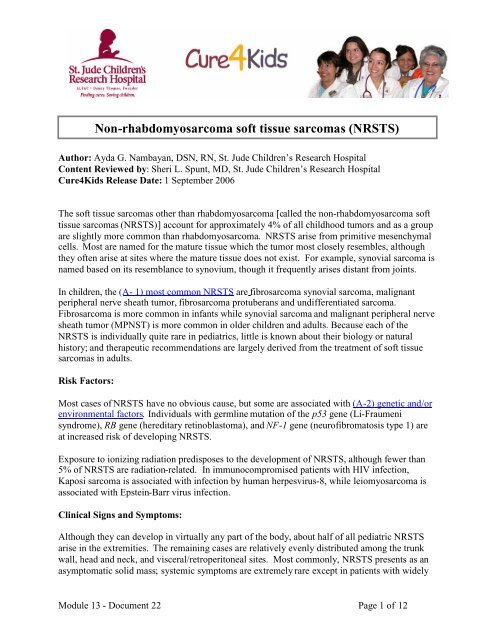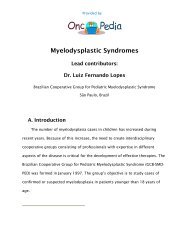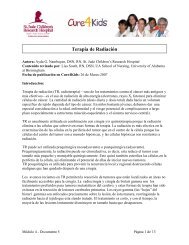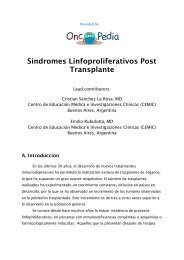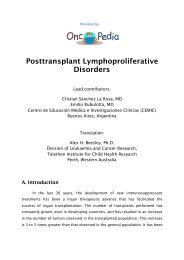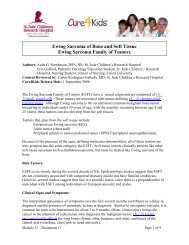Non-rhabdomyosarcoma soft tissue sarcomas (NRSTS)
Non-rhabdomyosarcoma soft tissue sarcomas (NRSTS)
Non-rhabdomyosarcoma soft tissue sarcomas (NRSTS)
Create successful ePaper yourself
Turn your PDF publications into a flip-book with our unique Google optimized e-Paper software.
<strong>Non</strong>-<strong>rhabdomyosarcoma</strong> <strong>soft</strong> <strong>tissue</strong> tumors (<strong>NRSTS</strong>)<br />
Author: Ayda G. Nambayan, DSN, RN, St. Jude Children’s Research Hospital<br />
Content Reviewed by: Sheri L. Spunt, MD, St. Jude Children’s Research Hospital<br />
Cure4Kids Release Date: 1 September 2006<br />
The <strong>soft</strong> <strong>tissue</strong> <strong>sarcomas</strong> other than <strong>rhabdomyosarcoma</strong> [called the non-<strong>rhabdomyosarcoma</strong> <strong>soft</strong><br />
<strong>tissue</strong> <strong>sarcomas</strong> (<strong>NRSTS</strong>)] account for approximately 4% of all childhood tumors and as a group<br />
are slightly more common than <strong>rhabdomyosarcoma</strong>. <strong>NRSTS</strong> arise from primitive mesenchymal<br />
cells. Most are named for the mature <strong>tissue</strong> which the tumor most closely resembles, although<br />
they often arise at sites where the mature <strong>tissue</strong> does not exist. For example, synovial sarcoma is<br />
named based on its resemblance to synovium, though it frequently arises distant from joints.<br />
In children, the (A- 1) most common <strong>NRSTS</strong> are fibrosarcoma synovial sarcoma, malignant<br />
peripheral nerve sheath tumor, fibrosarcoma protuberans and undifferentiated sarcoma.<br />
Fibrosarcoma is more common in infants while synovial sarcoma and malignant peripheral nerve<br />
sheath tumor (MPNST) is more common in older children and adults. Because each of the<br />
<strong>NRSTS</strong> is individually quite rare in pediatrics, little is known about their biology or natural<br />
history; and therapeutic recommendations are largely derived from the treatment of <strong>soft</strong> <strong>tissue</strong><br />
<strong>sarcomas</strong> in adults.<br />
Risk Factors:<br />
<strong>Non</strong>-<strong>rhabdomyosarcoma</strong> <strong>soft</strong> <strong>tissue</strong> <strong>sarcomas</strong> (<strong>NRSTS</strong>)<br />
Most cases of <strong>NRSTS</strong> have no obvious cause, but some are associated with (A-2) genetic and/or<br />
environmental factors. Individuals with germline mutation of the p53 gene (Li-Fraumeni<br />
syndrome), RB gene (hereditary retinoblastoma), and NF-1 gene (neurofibromatosis type 1) are<br />
at increased risk of developing <strong>NRSTS</strong>.<br />
Exposure to ionizing radiation predisposes to the development of <strong>NRSTS</strong>, although fewer than<br />
5% of <strong>NRSTS</strong> are radiation-related. In immunocompromised patients with HIV infection,<br />
Kaposi sarcoma is associated with infection by human herpesvirus-8, while leiomyosarcoma is<br />
associated with Epstein-Barr virus infection.<br />
Clinical Signs and Symptoms:<br />
Although they can develop in virtually any part of the body, about half of all pediatric <strong>NRSTS</strong><br />
arise in the extremities. The remaining cases are relatively evenly distributed among the trunk<br />
wall, head and neck, and visceral/retroperitoneal sites. Most commonly, <strong>NRSTS</strong> presents as an<br />
asymptomatic solid mass; systemic symptoms are extremely rare except in patients with widely<br />
Module 13 - Document 22 Page 1 of 12
<strong>Non</strong>-<strong>rhabdomyosarcoma</strong> <strong>soft</strong> <strong>tissue</strong> tumors (<strong>NRSTS</strong>)<br />
disseminated disease. Local invasion of adjacent anatomical structures may produce other<br />
symptoms.<br />
Patients may complain of pain, swelling, numbness, or loss of function, which might be due to<br />
neurovascular deficits caused by tumor invasion. Other complaints include respiratory<br />
difficulties that can be due to large chest wall tumors; and abnormal neurologic functioning due<br />
to CNS tumors. Hypoglycemia is sometimes seen with advanced hemagiopericytoma, and<br />
hyperglycemia has been observed in patients with fibrosarcoma of the lung.<br />
Approximately 15% of patients have metastatic disease at the time of initial presentation. The<br />
lung is by far the most common site of metastasis. Regional nodal involvement is rare except in<br />
selected histologies, such as clear cell sarcoma and epithelioid sarcoma. Liver, bone, brain, and<br />
<strong>soft</strong> <strong>tissue</strong> metastases are uncommon; bone marrow involvement is exceedingly rare.<br />
Diagnostic Work up and Staging/Classifications<br />
Incisional biopsy of the tumor is the gold standard approach to diagnosis, since an adequate<br />
specimen is critical for accurate identification of histologic subtype and grade. Multiple core<br />
needle biopsies may be an adequate alternative, but fine needle aspiration cytology is inadequate.<br />
Molecular pathologic studies to detect tumor-specific chromosomal abnormalities might also be<br />
useful.<br />
The World Health Organization system for classifying <strong>soft</strong> <strong>tissue</strong> tumors is most commonly used<br />
for diagnostic classification. This system divides tumors by clinical behavior into 4 categories:<br />
benign; intermediate, locally aggressive; intermediate, rarely metastasizing; and malignant.<br />
Assessment of tumor grade is a critical component of the initial diagnostic evaluation, since<br />
prognosis (and therefore treatment) depends largely on this factor. Tumor grade can be assigned<br />
using the (A-3) Pediatric Oncology Group system, designed specifically for pediatric <strong>NRSTS</strong>.<br />
Alternately, a grading system used for adult <strong>soft</strong> <strong>tissue</strong> <strong>sarcomas</strong> can be used. However, systems<br />
designed for adults do not account for tumors limited to pediatric disease, , such as infantile<br />
fibrosarcoma and infantile hemangiopericytoma.<br />
Clinical Laboratory Tests (renal and liver function tests) should be obtained prior to initiation of<br />
treatment in patients who will receive chemotherapy.<br />
Imaging Studies - The primary tumor should generally be evaluated with MRI, which provides<br />
optimal definition of local disease extent. For tumors within the chest and abdominal cavities,<br />
CT may be substituted. Imaging of regional lymph nodes is indicated for tumors associated with<br />
a significant likelihood of nodal involvement, but sentinel lymph node mapping may be more<br />
sensitive than diagnostic imaging for identifying occult nodal disease.<br />
A chest x-ray or CT scan is obtained in all patients due to the predominance of pulmonary<br />
metastases in <strong>NRSTS</strong>. Bone scintigraphy is restricted to patients with bone pain or other sites of<br />
metastasis; liver imaging is necessary only in those with intra-abdominal and retroperitoneal<br />
tumors. Brain imaging may be restricted to symptomatic patients and perhaps to those with<br />
widespread metastatic disease.<br />
Module 13 - Document 22 Page 2 of 12
<strong>Non</strong>-<strong>rhabdomyosarcoma</strong> <strong>soft</strong> <strong>tissue</strong> tumors (<strong>NRSTS</strong>)<br />
Lumbar Tap/CSF examination is necessary only in patients with tumors arising in cranial and<br />
paraspinal parameningeal sites.<br />
Staging:<br />
There is no standardized clinical staging system for pediatric <strong>NRSTS</strong>, so most clinicians use the<br />
(A-4) AJCC/UICC (American Joint Commission on Cancer/International Union Against Cancer)<br />
system to categorize patients by risk. The (A – 5) surgicopathologic staging system used by the<br />
Intergroup Rhabdomyosarcoma Study for Rhabdomyosarcoma, which assesses the extent of<br />
tumor present after initial surgery, is also occasionally used.<br />
Prognosis<br />
(A – 6) Prognosis depends on tumor grade and size, the extent of tumor resection, and the<br />
presence or absence of metastatic disease. High risk patients include those with metastatic<br />
disease, whose likelihood of survival is in the 15% range. Intermediate risk patients have an<br />
approximately 50% chance of survival and include those with non-metastatic but unresectable<br />
tumors, and those with resectable tumors that are both high grade and > 5 cm in diameter. The<br />
outlook for low-risk patients is excellent, with survival in excess of 90%. Low-risk patients<br />
include those with resectable low-grade tumors and those with resectable high-grade tumors that<br />
are ≤5 cm in diameter.<br />
Treatment<br />
There have been few prospective clinical trials in pediatric <strong>NRSTS</strong>, so the treatment approach in<br />
children is largely derived from data in adults with <strong>soft</strong> <strong>tissue</strong> <strong>sarcomas</strong>. However, the clinical<br />
behavior of certain histologic subtypes differs from that in adults, so this approach must be used<br />
cautiously. Some therapeutic considerations may differ in childhood, where therapy may have a<br />
deleterious impact on normal growth and development. Further, patients have many decades to<br />
develop late complications such as second malignant neoplasms, so treatment must be applied<br />
judiciously. Treatment of pediatric <strong>NRSTS</strong> should be planned by a multidisciplinary team<br />
composed of pediatric oncologists, surgeons, and radiation oncologists. Outside a clinical trial<br />
setting, treatment plans should be individualized with the goal of maximizing tumor control and<br />
minimizing short- and long-term morbidity.<br />
Surgical Management: Surgery is a mainstay of <strong>NRSTS</strong> treatment, and cure is rare if gross tumor<br />
is not excised. Therefore, the goal is to resect all sites of disease with wide margins. Repeated<br />
operations, including morbid procedures, may be necessary to achieve this goal. Neoadjuvant<br />
therapy (chemotherapy and/or radiotherapy) can be helpful in some cases to facilitate tumor<br />
resection.<br />
Radiation Therapy is useful for achieving durable local control in patients with microscopic<br />
residual disease after surgery. However, unlike in <strong>rhabdomyosarcoma</strong>, gross tumor control by<br />
radiotherapy is very poor. Radiotherapy may also play a neoadjuvant role in shrinking an<br />
otherwise unresectable tumor to facilitate surgery. Radiotherapy must be used judiciously, given<br />
its potential for serious long-term morbidity in children. Newer techniques such as interstitial<br />
brachytherapy might achieve adequate tumor control with fewer long-term toxicities in selected<br />
cases.<br />
Module 13 - Document 22 Page 3 of 12
<strong>Non</strong>-<strong>rhabdomyosarcoma</strong> <strong>soft</strong> <strong>tissue</strong> tumors (<strong>NRSTS</strong>)<br />
Chemotherapy has not been proven to improve outcome substantially in adults with <strong>soft</strong> <strong>tissue</strong><br />
<strong>sarcomas</strong>, so its use remains controversial. However, it has a clear place in the neoadjuvant<br />
setting for patients with unresectable tumors, where it may facilitate gross tumor resection. The<br />
benefit of chemotherapy in the adjuvant treatment of children with <strong>NRSTS</strong> is less clear, though it<br />
is likely to be most helpful in patients with non-metastatic, large, high-grade tumors who are at<br />
high risk for distant metastatic recurrence. Even in this population, its use may be appropriately<br />
restricted to histologic subtypes known to be relatively chemosensitive, such as synovial<br />
sarcoma.<br />
Future Directions:<br />
Studies aimed at improving our understanding of the biology and clinical behavior of <strong>NRSTS</strong> are<br />
underway. Although surgery remains the most important treatment modality, the roles of<br />
chemotherapy and radiation therapy are being investigated. Risk-based treatment approaches are<br />
being tested in both U.S. and European studies to determine which patients require adjuvant<br />
therapy. Further study is also needed to assess the long-term toxicity of various treatment<br />
approaches in <strong>NRSTS</strong>.<br />
Module 13 - Document 22 Page 4 of 12
Helpful Web Links:<br />
<strong>Non</strong>-<strong>rhabdomyosarcoma</strong> <strong>soft</strong> <strong>tissue</strong> tumors (<strong>NRSTS</strong>)<br />
National Cancer Institute – Childhood Soft Tissue Sarcoma<br />
http://www.cancer.gov/cancertopics/pdq/treatment/child-<strong>soft</strong>-<strong>tissue</strong>-sarcoma/HealthProfessional/page1<br />
St. Jude Children's Research Hospital<br />
http://www.stjude.org/disease-summaries<br />
eMedicine – <strong>Non</strong> <strong>rhabdomyosarcoma</strong>tous <strong>soft</strong> <strong>tissue</strong> sarcoma<br />
http://www.emedicine.com/ped/topic2764.htm<br />
Related www.Cure4Kids.org Seminars<br />
Seminar #413 Soft Tissue Sarcoma in a 21 Month-Old<br />
Leo Hamilton, MD, Jesse J. Jenkins, III, MD and Fredric Hoffer, MD<br />
http://www.cure4kids.org/seminar/413<br />
Seminar #262 Local Management of <strong>Non</strong>-Rhabdo Soft Tissue Sarcomas<br />
Matthew J. Krasin, MD, Christine Fuller, MD and Fredric Hoffer, MD<br />
http://www.cure4kids.org/seminar/262<br />
Seminar #83 Metastatic Leiomyosarcoma in a child with AIDS<br />
Sheri Spunt, MD, Jesse J. Jenkins, III, MD, Beth McCarville, MD and Jeffrey T. Sample, PhD<br />
http://www.cure4kids.org/seminar/83<br />
Seminar #103 Recurrent Chondrosarcoma Post-op Intensity Modulated Radiation Therapy<br />
Najat C. Daw, MD, Sandeep Samant, MD, Jeffrey Buchsbaum, MD, PhD, Christine Fuller, MD and<br />
Kathleen J. Helton, MD<br />
http://www.cure4kids.org/seminar/103<br />
Module 13 - Document 22 Page 5 of 12
Appendix:<br />
<strong>Non</strong>-<strong>rhabdomyosarcoma</strong> <strong>soft</strong> <strong>tissue</strong> tumors (<strong>NRSTS</strong>)<br />
A – 1 10 Most Common <strong>NRSTS</strong> in Childhood According to SEER Registry Data –<br />
Rhabdomyosarcoma (41.3%)<br />
Dermatofibrosarcoma protuberans (8.4%)<br />
Synovial sarcoma (7.7%)<br />
Sarcoma NOS (5.4%)<br />
Malignant fibrous histiocytoma (4.9%)<br />
Fibrosarcoma (4.5%)<br />
Malignant peripheral nerve sheath tumor (3.4%)<br />
Liposarcoma (2.8%)<br />
Epithelioid sarcoma (2.0%)<br />
Leiomyosarcoma (1.8%)<br />
From Spunt SL and Pappo AS, J Clin Oncol 24:1958-9, 2006<br />
Infantile fibrosarcoma:<br />
This is the most common <strong>soft</strong> <strong>tissue</strong> sarcoma found in children under one year of age. It presents<br />
as a rapidly growing mass at birth or shortly after. This form of fibrosarcoma tends to behave in<br />
a more benign fashion than fibrosarcoma in older children, which behaves more like the type<br />
found in adults.<br />
Courtesy of C. Rodriguez-Galindo, MD Synovial Sarcoma<br />
St Jude Children’s Research Hospital Sidney Kimmel Comprehensive Cancer Center at Johns Hopkins<br />
http://www.hopkinskimmelcancercenter.org/kpr/sarcoma<strong>soft</strong><strong>tissue</strong>.cfm<br />
Go Back<br />
Module 13 - Document 22 Page 6 of 12
A – 2 Factors Implicated in <strong>NRSTS</strong><br />
<strong>Non</strong>-<strong>rhabdomyosarcoma</strong> <strong>soft</strong> <strong>tissue</strong> tumors (<strong>NRSTS</strong>)<br />
Histology Chromosomal aberrations Genes involved<br />
Dermatofibrosarcoma t(17;22)(q22;q13) COL1A1/PDGFB<br />
Infantile fibrosarcoma t(12;15);+11; also +8,+17,+20 ETVG(TEL)/NTRK3<br />
Malignant peripheral nerve sheath tumor Deletion 17q11.2<br />
Malignant fibrous histiocytoma 19p+, ring chromosome<br />
Hemangiopericytoma t(12;19)(q13;q13.3) and t(13;22)(q22;q13.3)<br />
Alveolar <strong>soft</strong> part sarcoma t(x;17)(p11.2;q25) ASPL/TFE3 [8,9]<br />
Leiomyosarcoma t(12;14)<br />
Synovial sarcoma t(x;18)(p11.2;q11.2) SYT/SSX<br />
Extraskeletal myxoid chondrosarcoma t(9;22)(q22;q12) EWS-CHN<br />
Clear cell sarcoma (MMSP**) t(12;22)(q13;q12) ATF1/EWS<br />
Myxoid liposarcoma t(12;16)(q13;p11) FUS/CHOP<br />
Desmoplastic small round cell tumors t(11;22)(p13;q12) WT1/EWS [2]<br />
Low-grade fibromyxoid sarcoma t(7;16)(q33;p11) FUS/BBF2H7<br />
** Malignant melanoma of <strong>soft</strong> parts<br />
Adapted from Sandberg AA: Translocations in malignant tumors. Am J Pathol 159 (6): 1979-80, 2001<br />
National Cancer Institute<br />
http://www.cancer.gov/cancertopics/pdq/treatment/child-<strong>soft</strong>-<strong>tissue</strong>-sarcoma/HealthProfessional<br />
Congenital Syndromes:<br />
Beckwith-Wiedemann 11p15, CDKN1C, IGF2, myxomas,fibromas, hemartomas,<br />
<strong>rhabdomyosarcoma</strong>, Wilms tumor, pancreatoblastoma,<br />
hepatoblastoma<br />
Carney Complex 17q23-4, PRKAR1AK, 2p16, myxomas, melanocytic<br />
schwannomas, GIST<br />
Diaphyseal Medullary Stenosis 9q21-2, pleomorphic undifferentiated sarcoma<br />
Familial adenomatous polyposis and 5q21, APC, desmoids, colon cancer<br />
familial infiltrative fibromatosis<br />
Myofibromatosis Autosomal recessive, myofibromas<br />
Neurofibromatosis Type 1 17q11, NF1, neurofibroma, MPNST, pheochromocytoma<br />
Neurofibromatosis Type 2 22q12, NF2, schwannoma, auditory neuroma<br />
Retinoblastoma 13q14, RB1, retinoblastoma, osteosarcoma, <strong>soft</strong> <strong>tissue</strong> <strong>sarcomas</strong><br />
Rhabdoid predilection Syndrome 22q11, SMARCB1, rhabdoid tumor, atypical teratoid/rhabdoid<br />
tumor<br />
Rubenstein-Taybi Syndrome Myogenic <strong>sarcomas</strong><br />
Werner Syndrome 8p11-12, WRN, bone and <strong>soft</strong> <strong>tissue</strong> <strong>sarcomas</strong><br />
Okcu, MF., Hicks, J., Merchant, T., Andrassy, RJ., Pappo, AS., Horowitz, ME., <strong>Non</strong><strong>rhabdomyosarcoma</strong>tous Soft Tissue Sarcomas. In Pizzo, P.<br />
and PoplacK, D. Principles and Practice of Pediatric Oncology, 5 th Ed., Lippincott, Williams and Wilkins Co., Philadelphia, PA 2006<br />
Go Back<br />
Module 13 - Document 22 Page 7 of 12
<strong>Non</strong>-<strong>rhabdomyosarcoma</strong> <strong>soft</strong> <strong>tissue</strong> tumors (<strong>NRSTS</strong>)<br />
A-3 Pediatric Oncology Group (POG) Grading System for STS other than<br />
Rhabdomyosarcoma<br />
Grade 1 –<br />
Grade 2 –<br />
Grade 3<br />
Myxoid and well-differentiated liposarcoma<br />
Deep-seated dermatofibrosarcoma protuberans<br />
Well-differentiated or infantile (age 15% of the tumor show a geographic necrosis.<br />
High cellularity and significant pleomorphism are secondary criteria that can be<br />
used in assignment of borderline cases.<br />
Go Back<br />
Module 13 - Document 22 Page 8 of 12
<strong>Non</strong>-<strong>rhabdomyosarcoma</strong> <strong>soft</strong> <strong>tissue</strong> tumors (<strong>NRSTS</strong>)<br />
A – 4 American Joint Commission on Cancer (AJCC) Stage Grouping<br />
Stage Tumor (T) Node Metastasis 4 tiered 3 tiered Grade<br />
(N) (M) Grading** Grading**<br />
Stage I T1a, 1b, 2a, 2b N0 M0 G 1-2 G 1 Low<br />
Stage II T1a, 1b, 2a N0 M0 G 3-4 G 2 -3 High<br />
Stage III T2b N0 M0 G 3-4 G 2-3 High<br />
Stage IV Any T N1 M0 Any G Any G High or Low<br />
Any T N0 M1 Any G Any G High or Low<br />
** 4 tiered system: Grade 1 and 2 = Low; Grade 3 and 4 = High<br />
3 tiered system: Grade 1 = Low; Grade 2 and 3 = High<br />
Definitions:<br />
T -- Primary tumor<br />
TX primary tumor cannot be assessed<br />
T0 No evidence of primary tumor<br />
T1 Tumor 5 cm or less in greatest dimension<br />
T1a superficial tumor<br />
T1b deep tumor<br />
T2 Tumor more than 5 cm in greatest dimension<br />
T2a superficial tumor<br />
T2b deep tumor<br />
� Superficial tumor located exclusively above the superficial fascia without invasion of the fascia<br />
� Deep tumor is located either exclusively beneath the superficial fascia, superficial to the fascia with<br />
invasion of or through the fascia, or both superficial yet beneath the fascia.<br />
� Deep tumor classification also includes retroperitoneal, mediastinal, and pelvic <strong>sarcomas</strong>.<br />
N – Regional Lymph Nodes<br />
NX Regional lymph nodes cannot be assessed<br />
N0 No regional lymph node metastasis<br />
N1 Regional lymph node metastasis<br />
M – Distant Metastasis<br />
MX Distant metastasis cannot be assessed<br />
M0 No distant metastasis<br />
M1 Distant metastasis present<br />
G – Histologic Grade<br />
GX Grade cannot be assessed<br />
G1 Well differentiated<br />
G2 Moderately differentiated<br />
G3 Poorly differentiated<br />
G4 Poorly differentiated or undifferentiated<br />
Go Back<br />
Module 13 - Document 22 Page 9 of 12
<strong>Non</strong>-<strong>rhabdomyosarcoma</strong> <strong>soft</strong> <strong>tissue</strong> tumors (<strong>NRSTS</strong>)<br />
A -5 Intergroup Rhabdomyosarcoma Study Surgicopathologic Staging System<br />
Clinical Group I: Localized disease, completely resected<br />
a. confined to muscle or organ of origin<br />
b. contiguous involvement – infiltration outside the muscle or organ of origin,<br />
as through fascial planes<br />
Clinical Group II: Total gross resection with evidence of regional spread<br />
a. grossly resected tumor with microscopic residual disease<br />
b. regional disease with involved nodes, completely resected with no<br />
microscopic residual<br />
c. regional disease with involved nodes, grossly resected, but with evidence of<br />
microscopic residual and/or histologic involvement of the most distal regional<br />
node (from the primary site) in the dissection.<br />
Clinical Group III: Incomplete resection with gross residual disease<br />
a, after biopsy only<br />
b. after gross major resection of the primary (>50%)<br />
Clinical Group IV: distant metastatic disease present at onset<br />
Lung, liver, bones, bone marrow, brain and distant muscle and nodes. The presence<br />
of positive cytology in the cerebrospinal, pleural or abdominal fluids, as well as<br />
implants on pleural or peritoneal surfaces, are regarded as indications for<br />
categorizing the patients in this group.<br />
Go Back<br />
Module 13 - Document 22 Page 10 of 12
<strong>Non</strong>-<strong>rhabdomyosarcoma</strong> <strong>soft</strong> <strong>tissue</strong> tumors (<strong>NRSTS</strong>)<br />
A – 6 Estimates of survival of patients with initially resected, initially unresected, and<br />
metastatic <strong>NRSTS</strong> treated at St Jude Children’s Research Hospital.<br />
Spunt SL, Hill DA, Motosue AM, Billups CA, Cain AM, Rao BN, Pratt CB, Merchant TE, Pappo AS. Clinical features and outcome of<br />
initially unresected nonmetastatic pediatric non<strong>rhabdomyosarcoma</strong> <strong>soft</strong> <strong>tissue</strong> sarcoma. J Clin Oncol. 2002 Aug 1;20(15):3225-35.<br />
Abstract:<br />
http://www.ncbi.nlm.nih.gov/entrez/query.fcgi?orig_db=PubMed&db=PubMed&cmd=Search&term=J+CLIN+ONCOL%5BJour%5D+AND+20<br />
02%5Bpdat%5D+AND+spunt%5Bauthor%5D<br />
Go Back<br />
Module 13 - Document 22 Page 11 of 12
Acknowledgments:<br />
<strong>Non</strong>-<strong>rhabdomyosarcoma</strong> <strong>soft</strong> <strong>tissue</strong> tumors (<strong>NRSTS</strong>)<br />
Author: Ayda G. Nambayan, DSN, RN, St. Jude Children’s Research Hospital<br />
Content Reviewed by: Sheri L. Spunt, MD, St. Jude Children’s Research Hospital<br />
Edited by: Marc Kusinitz, PhD, St. Jude Children’s Research Hospital<br />
Cure4Kids Release Date: 1 September 2006<br />
Cure4Kids.org<br />
International Outreach Program<br />
St. Jude Children's Research Hospital<br />
332 N. Lauderdale St.<br />
Memphis, TN 38105-2794<br />
You may duplicate and redistribute this content in its entirety for educational purposes provided that the<br />
content is made available free of charge. This content may not be modified or sold. You can assist us in<br />
the development of additional free educational materials by sending us information about how and when<br />
you show this content and how many people view it. Send all comments and questions to<br />
nursing@cure4kids.org.<br />
© St. Jude Children's Research Hospital, 2006<br />
Last printed 7/29/2008 3:40:00 PM<br />
Last Updated: 9 June 2007: AS<br />
X:\HO\IO Edu Grp\Projects\NURSING COURSE\NCEnglish\Edited\Module 13\M13 final Revisions\NEM13D22V14.doc<br />
Module 13 - Document 22 Page 12 of 12


